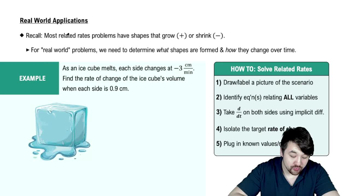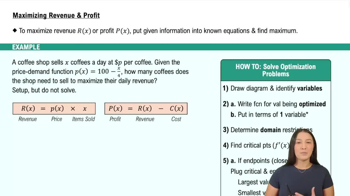Table of contents
- 0. Functions7h 52m
- Introduction to Functions16m
- Piecewise Functions10m
- Properties of Functions9m
- Common Functions1h 8m
- Transformations5m
- Combining Functions27m
- Exponent rules32m
- Exponential Functions28m
- Logarithmic Functions24m
- Properties of Logarithms34m
- Exponential & Logarithmic Equations35m
- Introduction to Trigonometric Functions38m
- Graphs of Trigonometric Functions44m
- Trigonometric Identities47m
- Inverse Trigonometric Functions48m
- 1. Limits and Continuity2h 2m
- 2. Intro to Derivatives1h 33m
- 3. Techniques of Differentiation3h 18m
- 4. Applications of Derivatives2h 38m
- 5. Graphical Applications of Derivatives6h 2m
- 6. Derivatives of Inverse, Exponential, & Logarithmic Functions2h 37m
- 7. Antiderivatives & Indefinite Integrals1h 26m
- 8. Definite Integrals4h 44m
- 9. Graphical Applications of Integrals2h 27m
- 10. Physics Applications of Integrals 2h 22m
5. Graphical Applications of Derivatives
Applied Optimization
Problem 48
Textbook Question
Find the height h, radius r, and volume of a right circular cylinder with maximum volume that is inscribed in a sphere of radius R.
 Verified step by step guidance
Verified step by step guidance1
Start by understanding the geometry of the problem: A right circular cylinder is inscribed in a sphere. The sphere has a fixed radius R, and the cylinder's height h and radius r are variables that need to be optimized for maximum volume.
Express the relationship between the cylinder and the sphere using the Pythagorean theorem. The diagonal of the cylinder (which is the diameter of the sphere) can be expressed as: <math xmlns="http://www.w3.org/1998/Math/MathML"><msqrt><msup><mi>h</mi><mn>2</mn></msup> + <mn>4</mn><msup><mi>r</mi><mn>2</mn></msup></msqrt> = <mn>2</mn><mi>R</mi></math>.
The volume V of the cylinder is given by the formula: <math xmlns="http://www.w3.org/1998/Math/MathML"><mi>V</mi> = <mi>π</mi><msup><mi>r</mi><mn>2</mn></msup><mi>h</mi></math>. Substitute the expression for h from the Pythagorean relationship into the volume formula to express V in terms of r alone.
Differentiate the volume function with respect to r to find the critical points. This involves using the chain rule and simplifying the derivative to find where it equals zero, indicating potential maximum volume.
Analyze the critical points and use the second derivative test or other methods to confirm which point gives the maximum volume. Ensure that the values of h and r satisfy the original geometric constraints of the problem.
 Verified video answer for a similar problem:
Verified video answer for a similar problem:This video solution was recommended by our tutors as helpful for the problem above
Video duration:
8mPlay a video:
Was this helpful?
Key Concepts
Here are the essential concepts you must grasp in order to answer the question correctly.
Right Circular Cylinder
A right circular cylinder is a three-dimensional geometric shape with two parallel circular bases connected by a curved surface at a fixed distance from the center. The height (h) is the distance between the bases, and the radius (r) is the radius of the circular bases. Understanding the properties of this shape is essential for calculating its volume and optimizing dimensions.
Recommended video:

Left, Right, & Midpoint Riemann Sums
Volume of a Cylinder
The volume (V) of a right circular cylinder is calculated using the formula V = πr²h, where r is the radius of the base and h is the height. This formula is crucial for determining the maximum volume of the cylinder inscribed within a sphere, as it directly relates the dimensions of the cylinder to its capacity.
Recommended video:

Example 5: Packaging Design
Inscribed Shapes
An inscribed shape is one that fits perfectly within another shape, touching it at certain points. In this case, the right circular cylinder is inscribed in a sphere of radius R, meaning that the cylinder's dimensions must be constrained by the sphere's radius. This relationship is key to solving the problem, as it involves using geometric properties and optimization techniques to find the maximum volume.
Recommended video:

Real World Application

 1:13m
1:13mWatch next
Master Intro to Applied Optimization: Maximizing Area with a bite sized video explanation from Callie
Start learningRelated Videos
Related Practice








